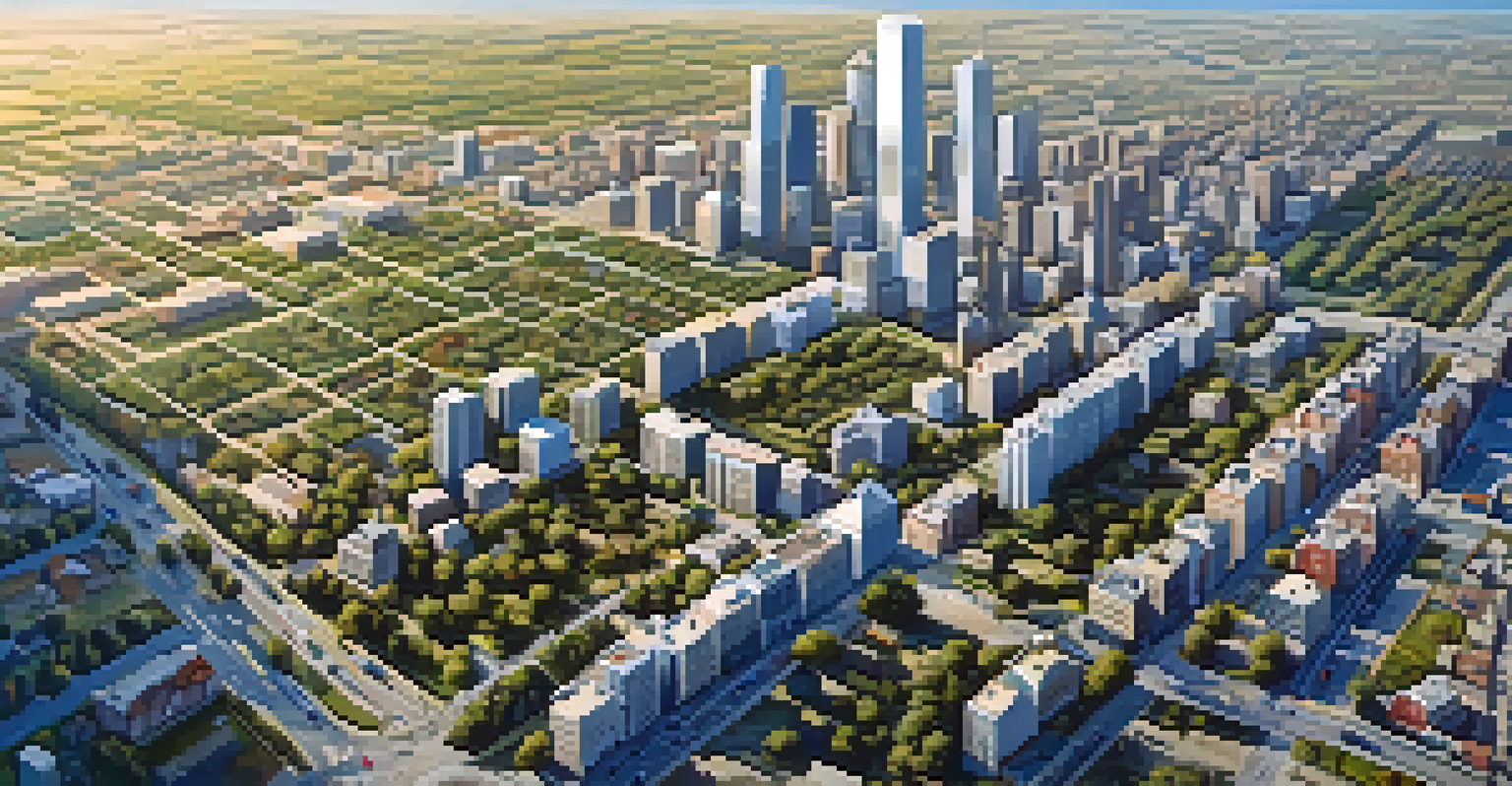Rural vs. Urban: How Location Affects Real Estate Prices

Understanding Real Estate Market Dynamics
When it comes to real estate, location is everything. Urban areas often have higher demand due to job opportunities and amenities, which can drive prices up. In contrast, rural locations might not offer the same level of amenities or job prospects, leading to lower property prices.
Location, location, location. It's the most important thing in real estate.
For instance, a two-bedroom apartment in a bustling city center may cost significantly more than a similar home in the countryside. This disparity arises from factors such as population density, infrastructure, and local economy. Understanding these dynamics helps buyers gauge what they can expect in various locations.
Ultimately, the balance between supply and demand is crucial. In urban areas, the high demand often outstrips supply, pushing prices higher, while rural areas may see ample supply but less demand, keeping prices lower.
The Role of Amenities in Price Variation
Amenities play a pivotal role in determining real estate prices. Urban centers are often teeming with restaurants, parks, shopping areas, and cultural attractions, making them highly desirable. These conveniences can elevate property values significantly.

Conversely, rural areas may offer a more tranquil lifestyle, but they often lack the same level of amenities, which can deter potential buyers. For example, a house in a rural area might be cheaper but could be miles away from the nearest grocery store or hospital. This lack of accessibility can lower its market value.
Location Drives Real Estate Prices
Urban areas typically have higher property values due to demand from job opportunities and amenities, while rural areas often see lower prices due to less demand.
However, the appeal of nature and open spaces can sometimes counterbalance this, attracting buyers looking for a quieter lifestyle. The key takeaway here is that while amenities influence prices, personal preferences also play a significant role.
Impact of Economic Factors on Prices
Economic factors are crucial in understanding real estate prices. Urban areas typically have more job opportunities, which can lead to a higher influx of residents. This increase in population fuels demand for housing, subsequently raising prices.
Real estate cannot be lost or stolen, nor can it be carried away. Purchased with common sense, paid for in full, and managed with reasonable care, it is about the safest investment in the world.
On the other hand, rural areas may struggle with economic growth, leading to stagnant or declining property values. For instance, small towns that experience a factory closure often see a sharp decline in real estate prices as job seekers leave in search of better opportunities elsewhere.
Thus, economic stability or growth within a region significantly impacts housing prices. Buyers should consider the broader economic context when evaluating properties in both rural and urban settings.
School Districts and Their Influence
The quality of local schools is another factor that can sway real estate prices. In urban areas, homes in highly-rated school districts often command a premium. Families prioritize education, and being near reputable schools can significantly boost property values.
Conversely, rural areas may have fewer educational options, which can affect demand. A house in a rural location with a subpar school district may struggle to attract buyers, resulting in lower prices. For example, a family might choose to pay more for a home in an urban area to ensure access to better educational opportunities for their children.
Amenities Influence Buyer Decisions
The presence of amenities such as schools and transportation options can significantly affect real estate prices, with urban areas generally offering more conveniences.
Therefore, potential buyers should always consider the implications of school districts on real estate values. The desire for quality education is a powerful motivator in the housing market.
Transportation and Accessibility Considerations
Transportation and accessibility are vital aspects of real estate pricing. Urban areas typically benefit from extensive public transportation networks, making commuting easier. This accessibility often leads to higher property values, as people are willing to pay more for convenience.
In contrast, rural areas may lack robust transportation options, leading to longer commutes and increased dependence on personal vehicles. This can make rural properties less attractive, resulting in lower prices. For instance, a home located near a subway station in a city can fetch a much higher price than a similar home located miles away from public transport.
Thus, the ease of getting around not only affects daily life but also plays a significant role in determining real estate values across different locations.
Lifestyle Preferences and Real Estate Choices
Lifestyle preferences significantly influence real estate decisions. Urban locations often attract those who enjoy vibrant city life, with its hustle and bustle, nightlife, and cultural activities. This desirability can lead to higher housing demand and prices.
On the flip side, rural living appeals to those seeking peace, open spaces, and a slower pace. Buyers looking for a retreat from city life may be willing to sacrifice some amenities for the tranquility of a rural setting. This unique appeal can lead to higher prices for certain rural properties, especially if they offer scenic views or recreational opportunities.
Investment Potential Varies by Area
While urban properties often appreciate rapidly due to constant demand, rural locations can provide unique investment opportunities with lower initial costs.
Ultimately, personal preferences drive real estate choices, creating a diverse market landscape where both urban and rural properties can thrive.
Investment Potential in Urban vs. Rural Areas
When considering investment potential, urban areas often present more opportunities. The constant influx of people and businesses can lead to property value appreciation over time, making urban real estate a popular choice for investors.
However, rural areas can also offer hidden gems. Properties in these locations may have lower initial costs, allowing for potential high returns if the area experiences growth in interest or development. For example, a rural property near a new business development could see its value rise dramatically.

Thus, both urban and rural areas present unique investment opportunities. Savvy investors should assess market trends, location potential, and future developments to make informed decisions.
Conclusion: Choosing the Right Location for You
In conclusion, choosing between rural and urban real estate hinges on various factors, including price, amenities, lifestyle preferences, and investment potential. Each location has its pros and cons, and what works for one person may not suit another.
It's essential to consider your priorities—whether it's access to city conveniences, a tranquil rural setting, or investment opportunities. Evaluating these factors can guide you toward the best decision for your unique situation.
Ultimately, the choice between rural and urban real estate is about finding the right fit for your lifestyle and financial goals. Whether you lean towards the buzz of city life or the serenity of the countryside, there's a place for everyone.